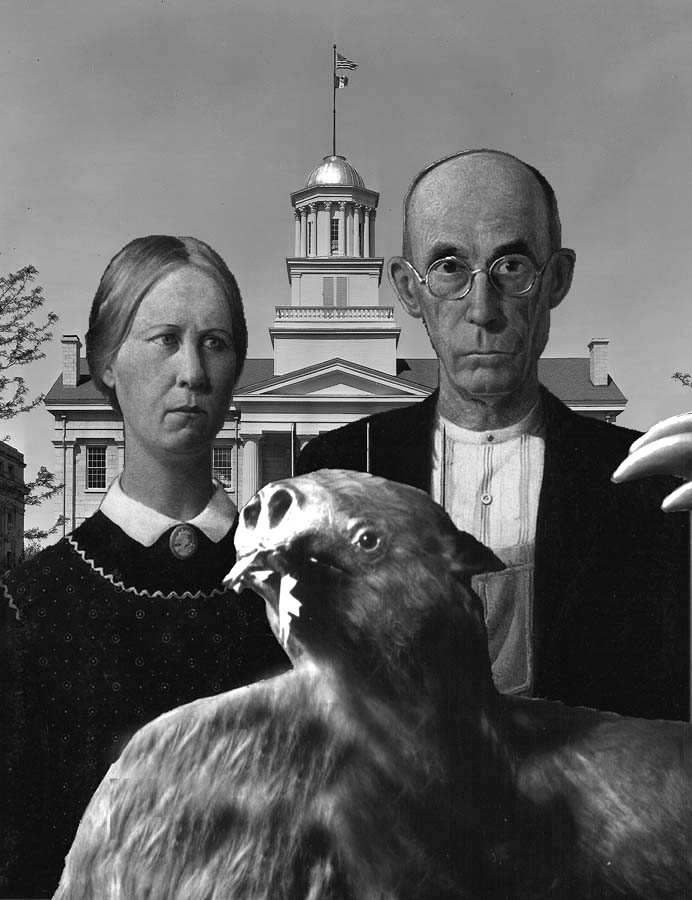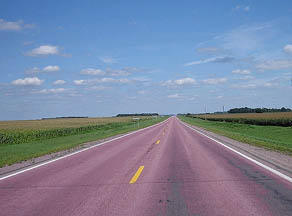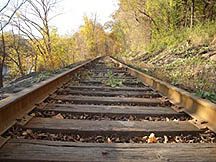I’ve been ruminating again about how our sloths might have died. Looking for fresh inspiration, I hiked down the Grant Wood trail here on the edge of Marion, IA to the Hughes peat bed, a site not unlike the ancient Tarkio Valley, where I recently learned a pair of bison–adult and juvenile– met their untimely ends 5,000 years ago.
The Grant Wood Trail starts on Hwy 13, just north of Squaw Creek Park and the Hwy. 100 intersection. It was created in 1999 by members of the Linn County Trails Association, (http://www.linncountytrails.org/) and donated to the county in 2005. The trail follows a route carved out by the defunct Chicago, Milwaukee, St. Paul and Pacific Railroad Company in 1872 on its way to Denver and places west. It was Marion’s lifeline and road to prosperity for 100 years. The company abandoned the line in 1980, but telegraph poles and remnants of old sidings still peek out from the overgrowth.
 The rolling hills that border the trail reminded residents of the paintings of a locally-born artist and time when more Iowans came from farms, but they speak to a geologist of a period more than 500,000 years ago when glaciers last visited these parts. Erosion and the intense cold of the last ice advance softened the contours of the landscape (Prior, 1991) but left loess-covered hills that still compel nearly every first-time visitor to remark, “I thought Iowa was flatter.”
The rolling hills that border the trail reminded residents of the paintings of a locally-born artist and time when more Iowans came from farms, but they speak to a geologist of a period more than 500,000 years ago when glaciers last visited these parts. Erosion and the intense cold of the last ice advance softened the contours of the landscape (Prior, 1991) but left loess-covered hills that still compel nearly every first-time visitor to remark, “I thought Iowa was flatter.”
The railroad company planned to stay a while–sections of the old roadbed are paved with sparkling pink Sioux quartzite. The rock is indestructible and has resisted erosion for 1.6 billion years where it is exposed in the NW corner of the state (Anderson, 1998).  More diligent early road builders–train and auto—decided it was well worth the extra expense of hauling the crushed rock across the state for the maintenance costs it saved forever after. Dorothy’s highway to Oz would have glistening pink if she had grown up a few hundred miles East.
More diligent early road builders–train and auto—decided it was well worth the extra expense of hauling the crushed rock across the state for the maintenance costs it saved forever after. Dorothy’s highway to Oz would have glistening pink if she had grown up a few hundred miles East.
Mammoth boulders line the fringes of the trail. Early observers called them “erratics,” recognizing their unusual character. Iowa’s long stay at the bottom of the sea left it with a surfeit of sedimentary deposits, but these rocks are igneous and metamorphic—granite mostly—and don’t belong. They were carried here from Canada by one of the early glacial advances and dumped. They are the oldest rocks exposed in Iowa, aside from the meteorites that drop in from time to time. Hikers walk passed them nowadays with hardly a glance, oblivious to their age and the unimaginable forces that brought them here. Early settlers noticed–identifying Iowa’s geological resources was a priority. Farming was too though, so they hitched up their teams and moved the smaller boulders into the farthest corners of these fields. The biggest ones show signs that maybe dynamite helped with the moving.
 Half way down the trail the land rises up on both sides as it cuts through a glacial paha—a Dakota Sioux word for hill (Anderson, 1998). Hurricane-force winds sweeping off the last glacier blew sand and silt into massive dunes like this hill, mostly trending NW to SE. Many an E. Iowa church, college or TV tower claims their peaks today, but the destiny of this paha lay in the calculations of a slick RR accountant. I wonder sometimes about railroad economics and why a company selects one path over another. . . and their capacity–financial and technological–literally to move mountains. The natural way forward for railroads is straight ahead, and in this instance they figured the fill they needed to bury the peat bog in their way lay just 1/4 mile further west . . . so onward! Who needs a glacier when you have a railroad? Did mining the peat before they buried it fit into their calculations? Probably.
Half way down the trail the land rises up on both sides as it cuts through a glacial paha—a Dakota Sioux word for hill (Anderson, 1998). Hurricane-force winds sweeping off the last glacier blew sand and silt into massive dunes like this hill, mostly trending NW to SE. Many an E. Iowa church, college or TV tower claims their peaks today, but the destiny of this paha lay in the calculations of a slick RR accountant. I wonder sometimes about railroad economics and why a company selects one path over another. . . and their capacity–financial and technological–literally to move mountains. The natural way forward for railroads is straight ahead, and in this instance they figured the fill they needed to bury the peat bog in their way lay just 1/4 mile further west . . . so onward! Who needs a glacier when you have a railroad? Did mining the peat before they buried it fit into their calculations? Probably.
Scattered along both sides of the trail are traces of another ancient relic—remnants of Iowa’s tall-grass prairie. Protection from rampaging plows and an occasional fire sparked by a passing train were the only breaks these plants asked for to survive. The tallest grass here is Spartina pectinata–prairie cord grass, or “ripgut” to those who know it especially well. (Run your hand along the leaf-edge carefully.) Cord grass loves deep poorly-drained soil, and its appearance here tells me, as it told early settlers arriving by wagon, that soggy ground lies ahead and it would be wise to steer for high ground. The grass spreads by extending its rhizomes and forms a thick gnarly mat which made the best sod houses (Madson, 1985). Each clump is a clone–one individual self-renewing plant. Spreading underground is common on the prairie–it’s difficult for seeds to get a toe-hold in the sod. How long a clone can live is anyone’s guess–possibly hundreds of years. . . thousands isn’t out of the question (Steinger et al., 1996). Sequoia trees tend to swagger, but this is Iowa, and our way is quiet dignity.
A sign overlooking the peat bed commemorates the discovery of a 5,000 year-old bison in 1969. The skeleton was complete and articulated. The animal may have been wandering through in the winter and broken through the ice. Unable to extricate itself from the muck, it looked like it just hunkered down to die (Semken, pers. com.). The spring that keeps water flowing freely through the peat bed even in drought years when the nearby creek dries up (Hall, 1971) probably keeps areas of the ice thin–a death trap for large animals that misstep. In 1988 the Cedar Valley Rocks and Minerals Society recovered a heifer and calf here lying side by side (Sonnleitner, pers. com.) which apparently died the same way. Could our sloths died like this? Not mired down certainly–our bones aren’t articulated. . . but we’ve had other indications that winter may figure in the puzzle (also see Micozzi, 1986).
The Hughes peat bed is a bona fide ice age relic. Hall (1971) dated the bottom layer to 11,880 years-old. Snails and pollen suggest the area was a boreal spruce forest which gave way to oaks and elms by 9,300 years ago. Ecologists would define this wetland as a spring fen—one of the rarest ecosystems in Iowa. Pearson and Leoschke (1992) cataloged over 200 unique native plant species living in fens–10% of our native flora on less than 0.01% of the land. Fens truly are our emerald cities, and the Hughes peat bed is still a gem despite 150 years of peat extraction (White, 1868). More about the importance of peat lands in the past and in our future next time. . . . Dave
References
Anderson, W.I. 1998. Iowa’s Geological Past: three billion years of change. University of Iowa Press, Iowa City, IA
Hall, S. A. 1971. Paleoecological interpretation of bison, mollusks and pollen from the Hughes peat bed, Linn County, Iowa. Masters Thesis, Department of Geology, University of Iowa.
Madson, J. 1985. Where the Sky Began. Houghton Mifflin Company, Boston MA
Pearson, J. A. and Leoschke, M. J. 1992. Floristic composition and conservation status of fens in Iowa. Journal of the Iowa Academy of Science 99: 41-52.
Prior, J. C. 1991. v Landforms of Iowa. University of Iowa Press. Iowa City, IA.
Steinger, T., Körner, C. and Schmid, B. 1996. Long-term persistence in a changing climate: DNA analysis suggests very old ages of clones of Alpine Carex curvula. Oecologia 105: 94-99.
White, C. A. 1868. First and Second Annual Report on the Geological Survey of the State of Iowa. Des Moines, IA.

